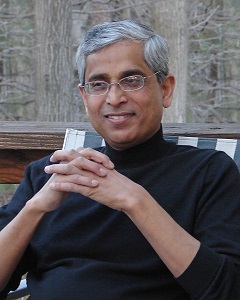Colloquium Announcement
Colloquium # 329
Orbital Debris-Generated KdV Solitons in the Ionosphere
By
Prof. Gurudas Ganguli
Plasma Physics Division, Naval Research Laboratory
Washington DC USA
Tuesday, 16th Jan at 3:30 PM
|

Abstract
Generation mechanism for KdV solitons due to speeding orbital debris in warm isothermal ionospheric plasma with the background magnetic field oriented at an arbitrary angle to the debris trajectory is analyzed. It is found that the fluctuations in the floating potential, which the debris acquires due to charging, can be amplified into growing ion acoustic waves by streaming ions on the debris. Normally, the ion acoustic fluctuations are ion Landau damped in the ionosphere because their phase speed matches the acoustic speed for equal ion and electron temperatures. However, in the debris frame the plasma streams with an inhomogeneous velocity profile. The velocity shear in the streaming ions can overcome Landau damping by effectively increasing the wave phase speed by a factor proportional to the product of the shear and the wave normal angle, causing dislocation of the Landau resonance. Consequently, the fluctuations can grow to sufficiently large amplitudes even in an isothermal plasma and trigger nonlinear effects resulting in KdV solitons. For debris motion at an angle to the magnetic field unique signatures are generated by the combination of coherent and incoherent processes in both along and across the magnetic field directions that may be exploited for distinguishing the debris-generated signatures from those due to natural causes for positive identification of the orbital debris.
About the Speaker
Dr. Ganguli is the Senior Scientist for Intense Particle Beams and Plasma Processes in the Plasma Physics Division, Naval Research Laboratory (NRL). Prior to this appointment he was the Head of the Space Analysis and Applications Section, Plasma Physics Division. He has a broad range of experience in plasma processes including beam-plasma interactions, plasma turbulence, dusty plasma dynamics, laser-produced plasma expansion, and high energy density physics in hypervelocity impact of projectiles in space. His work has addressed both natural plasmas as well as induced disturbances in the near-earth space environment. He has developed space defense applications including (i) rapid remediation of pumped radiation belts, and (ii) elimination of small orbital debris, which are necessary for the protection of critical on-orbit space assets. His research has motivated a number of laboratory and space experiments. He has led several ONR/NRL, DTRA, DARPA, Air Force and NASA sponsored research programs involving beam-plasma interactions in ionospheric and magnetospheric plasmas as well as negative ion and dusty plasmas. He has authored/co-authored more than 180 publications. He is the recipient of 2014 E. O. Hulburt Award for science, several NRL Berman Awards for excellence in research publications, 2014 Edison Award for patent on a novel technique to de-orbit small orbital debris, and 2010 Technology Transfer Award. He was a member of the NRL Invention Evaluation Board and ONR panel member to upgrade the Navy S&T strategy plan in 2011 - 2012. He has been the thesisadvisor for a doctoral and a masters dissertation and member of several thesis committees for doctoral and masters candidates. He was the Chairman of the International Union of Radio Science, Commission H (US National Chapter), during 2002 – 2005. He is a Fellow of the American Physical Society, Adjunct Professor of Physics at West Virginia and Auburn Universities, and a member of the American Geophysical Union. He has given over 100 invited talks at various national and international institutions and was appointed by the American Physical Society as a Distinguished Lecturer in Plasma Physics for 2001 –2002.

